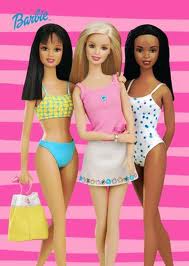 “There exists the phenomenon of whitening, and if you being black do not proclaim yourself to be so, you are in a demagogic position, of little ethic. In Cuban culture it is fundamental to achieve that people assume and be what they are. The defiance lies in forming a conscience, in which there will be no racial prejudice, stereotype and racism.”
“There exists the phenomenon of whitening, and if you being black do not proclaim yourself to be so, you are in a demagogic position, of little ethic. In Cuban culture it is fundamental to achieve that people assume and be what they are. The defiance lies in forming a conscience, in which there will be no racial prejudice, stereotype and racism.”
Dr Esteban Morales, Cuban political scientist and essayist
“Cuban Color”, Trabajadores (Workers) periodical, December 14, 2009, p. 7. Printed Edition.
The question came up by coincidence, while we were showing the nursery children the book “Barbie Anfitriona” –Barbie Hostess– (Mattel Inc., Megaediciones, 2003). Naturally, each girl wanted to be a Barbie. On the page offering recipes for a surprise lunch for the birthday of the best friend, there is a pretty photo with the three Barbies. Then a discussion began between two little ones whereby the one with very dark skin argues with her friend over the right to be the light-skinned Barbie with red hair. An incident without importance were it not for the glaring fact that the girl insisted and even cried because she was not black, but “mulata” (mestiza).
The results of the survey are not conclusive but have much in common with the experiences of North American lawyer Thurgood Marshall (1908-1993), who together with the Legal Defense Fund of the National Association for the Advancement of Colored People (NAACP), put together a panel of experts covering the fields of history, the economy, the political sciences and psychology. Of particular significance was a study in which psychologists Kenneth and Mamie Clark tried to determine how segregation affected the self-esteem and mental well-being of Afro North Americans. Among other impressive determinations, it was found that children between three and seven years of age preferred white dolls over black ones, all other things being equal.
Out of curiosity we made a superficial visit to the best-stocked toy stores in the Cuban capital and the observations made demonstrated that there are for sale no black dolls, or mestizas, although the offerings improve in stores specializing in handicrafts, in terms of those dolls dedicated to religious rituals, generally crafted of cloth and dressed in traditional garb. However it is relatively easy to buy at various prices, white dolls, be they Barbie or not, with straight hair in different colors, dressed with modern and elegant clothes.
It is absurd to evaluate racial and identity problems as something foreign to Cuban childhood. It is like attempting to cover the sun with one finger. Dr. Morales has demonstrated publicly the cultural insufficiencies in Cuban grade-school books in reference to African themes. It is known that “studies of gender and the feminist vision gave way in investigations and social analyses to other dimensions of inequality, such as racial, territorial, economic and of class” (http://www.amecopress.net/ January 27, 2012).
The sociological studies carried out by governmental organizations like the Centro de Investigaciones Psicológicas y Sociales (CIPS: Center for Psychological and Social Research) among others, demonstrate that since the decade of the 90’s of the 20th century, when the Cuban government introduced the economic reforms that accompanied the circulation of a double currency, “the losers” are women, the black and mestizo population, the migrant and elderly, sectors that have been able to take less advantage of the opportunities opened up by the reform.
It is not easy to find current Cuban studies about racism and its dismal influence over childhood. Due to the rapid growth of boys and girls, we do not have the power to change from one day to the next the low self-esteem of Afro-descendant children, but it is within the reach of ACDEI (ASOCIACIÓN CUBANA PARA EL DESARROLLO DE LA EDUCACIÓN INFANTIL– Cuban Association for the Development of Childhood Education) to stimulate the self-esteem and confidence in themselves of those we educate. We gave away photos of 2010’s Miss Universe to white girls with a simple dedication:
Mom, dad and family:
Your daughter __________ is very pretty and if she studies a lot, learns to defend herself and practices sports, come tomorrow she can be as beautiful as Miss Universe 2010.
We did the same with the Afro-descendant little girls. The only difference was in the photos of different moments of Angolan Leila Lopes, Miss Universe 2011, which were distributed among the little girls with the note written over the main photo, where the recently crowned queen smiles beside Miss Universe 2010.
We do not know if, as the children of the daycare grow, they will accept their ethnic background, but at least we assume as a duty to invite their families to reflect with optimism on the subject.
“No one can make you feel inferior without your consent.”. These are words of Eleanor Roosevelt, president of the commission that drew up the Universal Declaration of Human Rights in the United Nations. ACDEI works to successfully deliver a message to children, their families and educators. Cuba is a multiracial nation, therefore the absent dolls with other features and colors of skin are necessary toys in toy stores. Besides, the dolls that are already on sale are going to be very happy with their company. Dolls are not racist!
Translated by: Maria Montoto
June 1 2012
